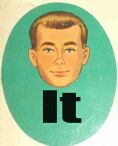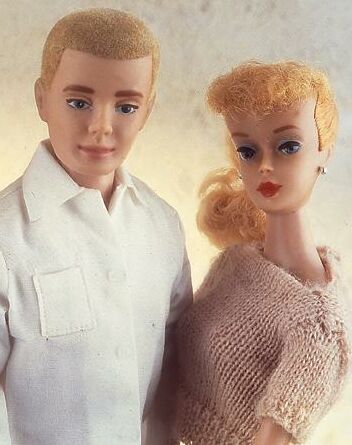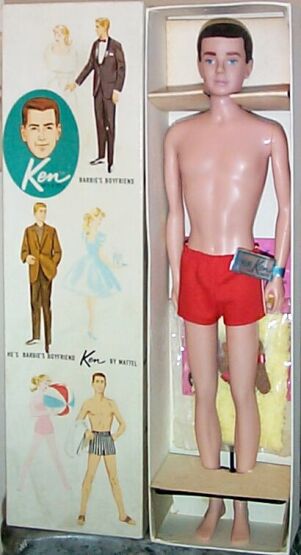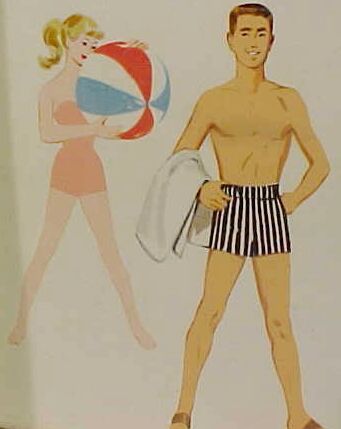This Feature Story appeared in the Keeping Ken Ken News! on May 23, 2001.
![]() Keeping Ken
Keeping Ken ![]() Ken News Feature Archive
Ken News Feature Archive
|
|
|
 wasn't whimsy...it was
consumer demand that eventually overcame Mattel's reluctance to make a
male doll, and in March 1961, Ken® was introduced. This feature will
examine the challenges Mattel faced in 1961 to create the perfect
companion, for an already perfect, personified doll. It will also
examine the era that forever forged an image that is remembered to the
present. But the thrust of this feature will examine how Ken®'s
carefully crafted image ultimately became a success in his first version,
the Flock Hair Ken®. Exactly why does this version become a focal
point of your collection? By examining the Flock Hair Ken®, one thing
becomes perfectly clear...it's really a combination of loving this version
and the history behind it. wasn't whimsy...it was
consumer demand that eventually overcame Mattel's reluctance to make a
male doll, and in March 1961, Ken® was introduced. This feature will
examine the challenges Mattel faced in 1961 to create the perfect
companion, for an already perfect, personified doll. It will also
examine the era that forever forged an image that is remembered to the
present. But the thrust of this feature will examine how Ken®'s
carefully crafted image ultimately became a success in his first version,
the Flock Hair Ken®. Exactly why does this version become a focal
point of your collection? By examining the Flock Hair Ken®, one thing
becomes perfectly clear...it's really a combination of loving this version
and the history behind it. |
|
| In
the beginning, God created man. Mattel created a woman first,
and the man would follow in her footsteps...indefinitely.
Because Mattel's Barbie® doll image became so successful in two
short years, the man had a lot to live up to. When Mattel
introduced Barbie® at the Toy Fair in 1959, there wasn't a
immediate response or sense of urgency from toy buyers to add her to
their store shelves. By 1960 however, the same toy buyers were
clamoring to get her. It was during the peak year of 1960 that
consumers were left wondering who Barbie® really was. If she
had all the "C" accessories (careers, clothes and clout),
why didn't she have a companion? Mattel’s teenage fashion
doll “Barbie®” was slowly becoming
an American icon.
Children across the nation were discovering that the Barbie doll
world was full of fantasy and enchantment.
But something was amiss in the imaginative play situations being
created. Sparked by the
notions of what teenagers were doing, Barbie®
was taking on
a more real suburban personality. With
this new personification, two things were missing: romance and
companionship. Before toy fair of 1960, a "male Barbie® doll" was proposed in meetings between Mattel executives. By all accounts (from printed media resources), Ruth Handler (who created the Barbie® doll), along with Charlotte Johnson (Barbie® doll's first dress designer) had the most influence in creating and fighting for the yet, unnamed male doll. It was these two ladies that battled it out with the male executives who weren't much interested in a male doll at all. This was probably due to the fact that the male doll's body form couldn't be agreed upon, let alone discussed. This topic is one of the most discussed in Ken® doll's 40 year history. It is important to realize that because of the sensitivity of the issue at hand, it was a giant hurdle to jump. To continue the design and eventual creation process, the body mold had to be discussed, and by all accounts heavily debated. The following is an excerpt form Forever Barbie®: The Unauthorized Biography of a Real Doll by M. G. Lord, which explains what was happening during this time period. The quotes are frank, so I hope you are not offended by the content. If you are easily offended, please skip to the next paragraph. |
|
| Above: Ken doll's first advertising in the Mattel dealer catalogue of 1961. Notice the black and white swim trunks made from the same material as Barbie doll's swimsuit. Although literally impossible to find, a small quantity of these versions were released. These trunks usually have Ken dolls with painted legs. | |
|
From Forever Barbie: The Unauthorized Biography of a Real Doll by M. G. Lord At Mattel, a storm raged over his genitalia. Ruth (Handler) and Charlotte (Johnson), who wanted what Ruth termed "a bulge" in his groin, squabbled with the male executives, who didn't. After the women vetoed a male doll that resembled Barbie in the crotch, three new versions were sculpted, with three degrees of what Charlotte called "bumps." "One was - you couldn't even see it," she said. "The next one was a little bit rounded, and the next one really was. So the men - especially one of the vice presidents - were terribly embarrassed. And he was a middle-aged man, you know - nothing to get so embarrassed about. So Mrs. Handler and I picked the middle one as being the one that was nice-looking. And he said he would never have it in the toy line unless we painted Jockey shorts over it." "None of us wanted a doll with a penis showing," Ruth amplified. "If the child took off the swimsuit, we felt it would be inappropriate with an adult boy to show the penis - so we all reached a conclusion that he should have a permanent swimsuit." All except Charlotte, that is. She said: "Do you know what every little girl in this country is going to do? They are going to sit there and scratch that paint off to see what's under it. What else would they do?" Reluctantly, the men agreed. Ken got his "bump," but in a version modified to fit under trousers. "I had to work with the sculptor a little bit," Charlotte said, "because I realized when we were putting zippers in the fly - and the zipper on top of that bump - it got bigger and bigger."
|
|
|
|
|
|
Above: A Blonde Flock Hair Ken® MIB with the box used for later versions. The signature white box characterization, which would be used through 1964, stays the same at the top and middle. At the bottom of the box we see him in the red swim trunks and red and white stripe beach jacket with a titian bubble cut Barbie®! Below: Ken® was the perfect gentleman and escort to Barbie®. Her intentions were questionable however in the Random Hose Books of the early Sixties. |
|
| With the
body mold decided, the male doll was quickly named. He was
named "Ken®" after Ruth's son. Initially, he was
not given a last name, but later he was mentioned as "Ken
Carson" in Random House Books written by Cynthia Lawrence and
illustrated by Clyde Smith. Ken® doll's personality was
established in these Random
House Books, as the sweet doting boyfriend. "Ken's
last name, and his father's profession, were established in the
Barbie books published in the mid 60's. It is unclear if his
parents were ever named, but his dad is a lawyer. His last
name came from the Carson- Roberts ad agency that worked with Mattel
to help advertise the Barbie doll in the early 60's. Of
course, this is also why Barbie is named Barbie Roberts," said
Michael J., a collector. Barbie®'s personality
was not so sweet and in retrospect,
you have to wonder why Mattel didn't proofread these books before
publication. Barbie® usually keeps Ken on the back burner as
she explores other romantic possibilities, and in some instances, is
down right mean to him. But she knows where her heart is and
Ken® is always forgiving and takes her back.
Later, "Ken's grandparents were featured in a couple of stories of the Barbie® comic books that Marvel did in the late 80's/early 90's. Ken's only other relative is, of course, his little brother Tommy™," said Michael. Tommy™, is also the only relative made into actual doll form. |
 |
|
Before the publication of the Random House books, Ken® was on the market in March 1961 with a lot of provided information about his duties, but with little information about his image or personality. I find this marketing strategy was a stoke of genius on Mattel's part, simply because Ken® could become whatever the consumer wanted him to be. Initially, Ken® is given only two important tasks to uphold. One being an escort and the other as boyfriend. Both tasks are centered towards Barbie®. Mattel will imply these tasks in the early months of 1961, when Ken® is featured in a black and white television commercial. In the commercial (with a high build of music), Barbie® is seen dressed in Enchanted Evening alone in a ballroom setting. With the use of animation, Barbie®’s head turns to see a Ken® dressed in Tuxedo #787. This is the first known meeting of the two and the commercial explains that Ken® is Barbie®’s new boyfriend. The commercial ends with her dressed in Wedding Day and him still in Tuxedo, leaving little to the imagination where the date will end. The duties were established and like all great products, Ken® was given not one but two trademarked slogans. Both trade marks slogans were used in printed and television commercial advertising. They were also printed on his original packaging. "He's A Doll!™" and "Barbie's Boyfriend™", would spell out his history. Which brings us to the actual doll.
|
|
|
From
Barbie Bazaar Magazine (PART
1 Vintage/Early Mod Era 1961-1972) The Ultimate Accessory…Ken! The first Flocked Hair (FH) Ken #750 (Box Date 1961) would prove to be confusing. The standard issues would be different, with added accessories and different colors of hair available as his manufacture continued. Very rare is the first swimsuit he wore, and Kens with painted legs. Prototype and first release Ken boxes pictured him in black with white stripe swim trunks (obviously to match Barbie’s swimsuit). This box characterized his image as escort and boyfriend with Barbie coyishly by his side. Ken is seen dressed in Tuxedo #787 (top), Dreamboat #785 (middle) and the black and white swim trunks holding the yellow towel around his right forearm (bottom). Beside him in the in this version of swim trunks we see a blonde ponytail Barbie. This box version is rare and denotes a first run box edition. In later versions, his signature white box characterization, which would be used through 1964, stays the same at the top and middle. At the bottom we see him in the red swim trunks and red and white stripe beach jacket with a titian bubble cut Barbie! In both box versions all the drawn characters are glancing at Barbie except for the bottom picture, in the swimsuit. Ken is represented looking proudly out at his adoring audience…with Barbie looking coyishly at HIM! The depictions on the boxes present the pair to be naive and innocent, yet sophisticated and suburban. Most first release FH Kens would come with swim trunks in solid red knit jersey, solid red poplin, or red poplin with white stripe on each side. Some came with a yellow towel, while others did not. Also optional was a red and white striped beach jacket with sewn in white terry cloth facing that seems to have been included with later manufactured issues. Most included red strap cork sandals, and all came with a genuine Ken wrist tag and black wire stand. Ken stood 12” tall, and you could choose from hair colors of blond, brunette or the JC Penney catalog exclusive brown, which was a reddish light brown. Most all of the heads of the FH Kens were wrapped in cello and rubber banded around his neck. His hair, as well as his wide stance and hollow torso easily identify FH Ken. His body mold is referred to as “Tan Straight Leg” and the markings are Ken T.M./Pats.Pend/© MCMLX/ by/ Mattel/ Inc. The head mold used is referred to as the “FH Ken” head mold and would only be used on these issues. All versions have painted blue eyes that look straight ahead with a sense of directness and a closed mouth. This head mold would have a short life after consumers found out the delicate flocking came off easily in water. Mattel solved this problem quickly with the second version of Ken, the Painted Hair Ken.
|
|
 |

|
|
Above Right: Brunette NRFB in the first release box. Above Left: Close-up of the Prototype and/or first release Ken® box that pictured him in black with white stripe swim trunks (obviously to match Barbie’s swimsuit). This box characterized his image as escort and boyfriend with Barbie® coyishly by his side. This box version is rarer and denotes a first run box edition.
|
|
|
The "Dobie" Factor
|
|
|
|
When looking into the historical events
that took place during the conception of Ken®, actor Dwayne
Hickman's name becomes synonymous with the event. Hickman
would become the star of The Many Loves of Dobie Gillis which
aired on television from 1959-1963. It was a spin-off of the
movie The Affairs of Dobie Gillis which was released in
1953. It starred Bobby Van and Debbie Reynolds.
Left: The movie The Affairs of Dobie Gillis released in 1953 starring Bobby Van and Debbie Reynolds. It would be the precursor to the television series starring Dwayne Hickman. Below: Still from the movie. The television series with Dwayne Hickman as "Dobie", portrayed him as the all- American boy next door who was always competing for the hand of Thalia Menninger (Tuesday Weld) from either Milton Armitage or the annoying Chatsworth Osbourne, Jr. (who was the rich kid that had everything). With the help of his good friend and sometimes wacky Maynard G. Krebbs (played by Bob Denver), the series plotted Dobie's amorous adventures from junior high to high school to college. Dobie would often be found sitting in front of a copy of Rodin’s statue The Thinker, from where he would engage in direct address to the audience, about the philosophical, and psychological problems of his life; the life of an American teenager. |
|
|
|
|
Many collectors attribute the likeness of the FH Ken® to that of Hickman. Although the resemblance is uncanny, Mattel with neither confirm or deny that the FH Ken was inspired from Hickman's appearance during any part of the design or sculpting. Ken was designed and sculpted during 1960 while the first season of the show was ending. Hickman became an instant star. In the latter part of 1960, Ken was patented by Mattel during the series' second season. With a similar likeness, the character of Dobie is also attributed to the character of Ken®. Mattel was trying to capture a boy-next-door "suburban" image for Ken®, and while Dobie wasn't completely wholesome, he did employ a clean-cut, good natured image. Roseanne Monk, a huge fan of the series and collector of "Dobie" memorabilia said that she agrees with the assumption that the FH Ken was modeled after Hickman. "I crossed the line in collecting to finally get a FH Ken doll (blonde of course). I call it my "Dobie doll", she said. "Of course a lot of collectors in my arena think there is a link between the two. The time-line of events are so close together. Last year I finally got a brunette version, because you know Hickman was really brunette and they bleached his hair for the part. In the last season of the show he was mostly brunette because he was tired of them bleaching his hair. Even though I know it's probably not true, I think this is why Mattel made a brunette and blonde version. Now I have a "on" and "off" season Dobie doll," she added jokingly.
Above: From the television series Maynard (left) and Dobie (right). "Beatnik" vs. "Clean-cut". "Teenagers, free from both the burdens of the Depression and the military duties required of previous generations, were defining themselves on the basis of music, dare-devil activities, specific consumptive habits, and a rebellious appearance, which horrified and frightened their elders. Not surprisingly, the American media was fairly bursting with advice and directives on how the new American family was to see itself". -Leibman, Nina C. Living Room Lectures: The Fifties Family in Film and Television. Austin, Texas: University of Texas Press, 1995. "The episodes were often little morality tales, (situations) in which Dobie and his friends would solve a problem in a "typical" All-American fashion. The programs were not political, or even socially conscious, they did seem to hue to the straight and narrow of mid-1950s, middle class, middle of the road social codes. Not with any sense of a crusade, but simply because that is the way things were done. There was something different about the show, not unique, but different from most shows of the time. It was aimed at the young audience, it had consciously taken the step toward "youth appeal", that Jim Aubery was taking at the rival ABC, and for which ministrations he would soon be brought back to CBS where he had developed Have Gun Will Travel a few years earlier. The Many Loves of Dobie Gillis was both aimed at the teen audience and had an oddball, bohemian, character (Maynard) who was totally out of step with the parental generation. Although most of the programs in the series strongly reinforced the status quo, and preached a typical fifties morality, Maynard G. Krebs was not included in the typical morality of the "straight" world that Dobie and his friends inhabited. By 1959 the baby boomers were moving through the population and were beginning to develop a taste and style of their own, a style or culture that was not merely a children’s version of their parent generation’s culture. Disneyland on ABC in 1954 and The Mickey Mouse Club in 1955, were both aimed squarely at the, as yet, pre teen baby boomers. But I don’t think we can say that they were old enough to have developed a world view that would stand out as distinct from their parents’. But by 1959 the hormones were kicking in and teenagers had begun to realize that they had a culture of their own. They could look back to the recent past at Marlon Brando in the Wild One, 1953, and James Dean in Rebel Without A Cause in 1955. These actors had set the examples of young people estranged from their society and facing the angst of a world that for them was no longer post-war, but had yet to become psychedelicized. Allan Freed, and other Disc Jockeys such as "Dandy" Dan Ingram, Murray "The K" Kaufman "Cousin" Bruce Murrow, and Wolfman Jack had developed followings of young people who were living the rock and roll lifestyle. Clothing styles featured tight "pegged" pants and thin ties. The most important colors were black and white. This teen cohort dovetailed with a somewhat older group of intransigents whom the press called "beatniks." -DOBIE GILLIS: THE STRUCTURAL STRATEGY OF JUXTAPOSING THE TEENAGE OUTSIDER AND THE MAINSTREAM SITCOM FAMILY (An early draft of this study was presented at the Nina Leibman panel at the UFVA conference at Chapman University in 1996).
Above: 1959 TV Magazine cover. In retrospect, if Mattel designers were creating the All-American teenage boy, and using Hickman as a model, they aimed their direction away from social issues facing teenagers at this time. In other words, the character of Dobie was fine, Maynard was not. While the program was aimed directly at the new "teenage" generation of the late 1950s, the doll version "Ken®" would be aimed at a younger audience not yet versed in teenage activities, but akin to acting them out in play situations. Mattel would chose to represent Ken® in a pre-teen ideal culture, instead of the real teen culture to capture their core consumer. |
|
|
|
"The Many Loves of Dobie
Gillis"
|
| Whether you buy the
Dobie theory or not, exactly what is it about the FH Ken that makes
Ken collectors unite? Looking past the historical elements of this
version and it's conception, what is it about him that makes him a
favorite?
I usually end my features with "unanswered" questions (like the ones above) to make you think a little about why you collect Ken®. I think both questions can be answered in two words: "boyish charm". No other Ken® version has ever been able to capture the adoring (and somewhat determined) look of the FH Ken. A combination of the head mold (and facial painting) and the smaller framed body mold indeed captures your attention. While some Ken versions speak volumes for fads or time eras, the FH Ken captures an innocence that becomes instantly charming. So does he fulfill his duties as escort/boyfriend? As escort, Ken® appears to be a perfect gentleman and a lot less alluring than his girlfriend. When matched together, a #1 through #4 Barbie® is the attention seeker with that "look at me" look. Ken® on the other hand looks comfortable in his position, but a lot less worldly, which was probably Mattel's intention in the first place. But he doesn't get lost in her spot light or glamorous lifestyle. He looks like a companion, not like (dare I say it) an accessory. As boyfriend, Ken® is always there for Barbie®. With every Barbie® themed function, he is properly dressed, and still appears to be slightly enjoying himself, and never slightly annoyed. His predecessor Painted Hair Ken, looks a little uneasy in the same outfits. The Flock Hair gracefully began the tradition that would become Ken's future. If it weren't for the FH Ken®, this website wouldn't exist and I wouldn't have anything I truly enjoyed as a child to still enjoy today! But beyond that, if the FH Ken had never been made...Barbie® wouldn't have a boyfriend. Without him, who would tell her she looked great in the Enchanted Evening dress? ...and being crowned "Queen of the Prom" wouldn't be fun without a date. |
|